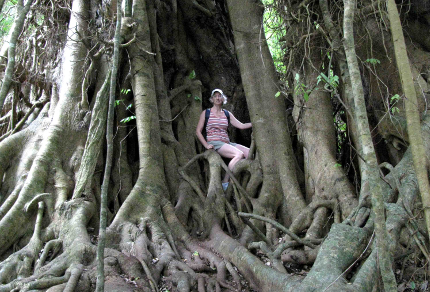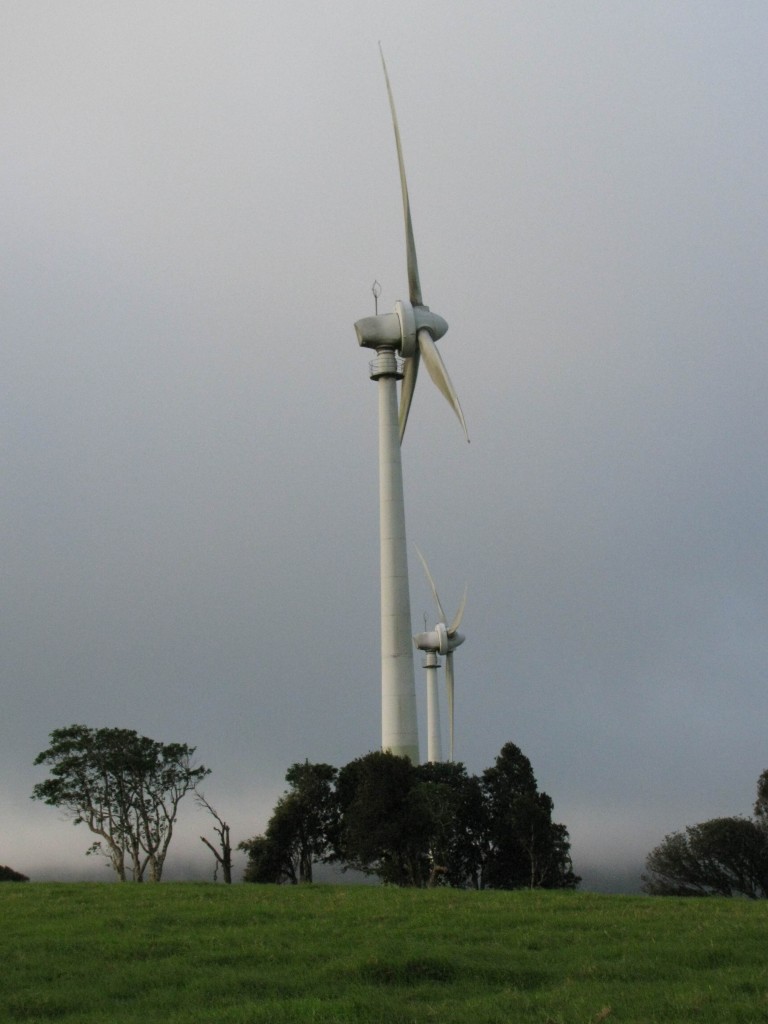
Windy Hill Turbines (© Vilis Nams)
After a hot porridge breakfast, we broke camp at Tall Timbers and drove north past dairy herds, mist-shrouded hills, and the wind turbines rearing against their backdrop of lush green pastures, wind-stunted trees, and speeding clouds. The entire landscape was a mosaic of rolling pastures and groves of tree ferns and tropical trees of varying form – some flat-topped, some with rounded crowns, and some slim-boled palms with flaring fronds. I found myself comparing the Atherton Tablelands with the Victoria rangelands we drove through northeast of Melbourne in mid-March, and came up with three basic differences: 1) moisture – the Tablelands pastures were drenched in verdant green, as opposed to the drier, tawny rangeland vegetation of Victoria; 2) topography – although expansive, the Tablelands rolled on a smaller scale, with short, pimple-like hills rather than the long, sweeping rises and broad valleys of Victoria; 3) trees – whereas the rainforests of the Tablelands grazing land consisted of pockets of lush trees cloaked with densely-leaved vines, the Victoria rangeland woodlands had consisted of scattered, crooked gums with dusty leaves.
While driving, we observed cattle egrets riding red beef cattle and striding in green pastures beside them. Road cuts exposed soil the colour of red ochre that looked like bleeding wounds in an otherwise lushly verdant landscape. Ten kilometres north of Malanda, we pulled into the Lake Eacham section of Crater Lakes National Park in the eastern Tablelands.
Crater Lakes National Park consists of two enclaves of rainforest surrounding two volcanic crater lakes, the other being Lake Barrine a few kilometres to the north. Formed by explosions caused by super-heated water trapped underground,1 the freshwater lakes are circular in shape, about a kilometre across, and 65 metres deep.2 Under cloudy skies, Lake Eacham’s still, dark green waters looked opaque and uninviting, although only mildly cool to my touch.
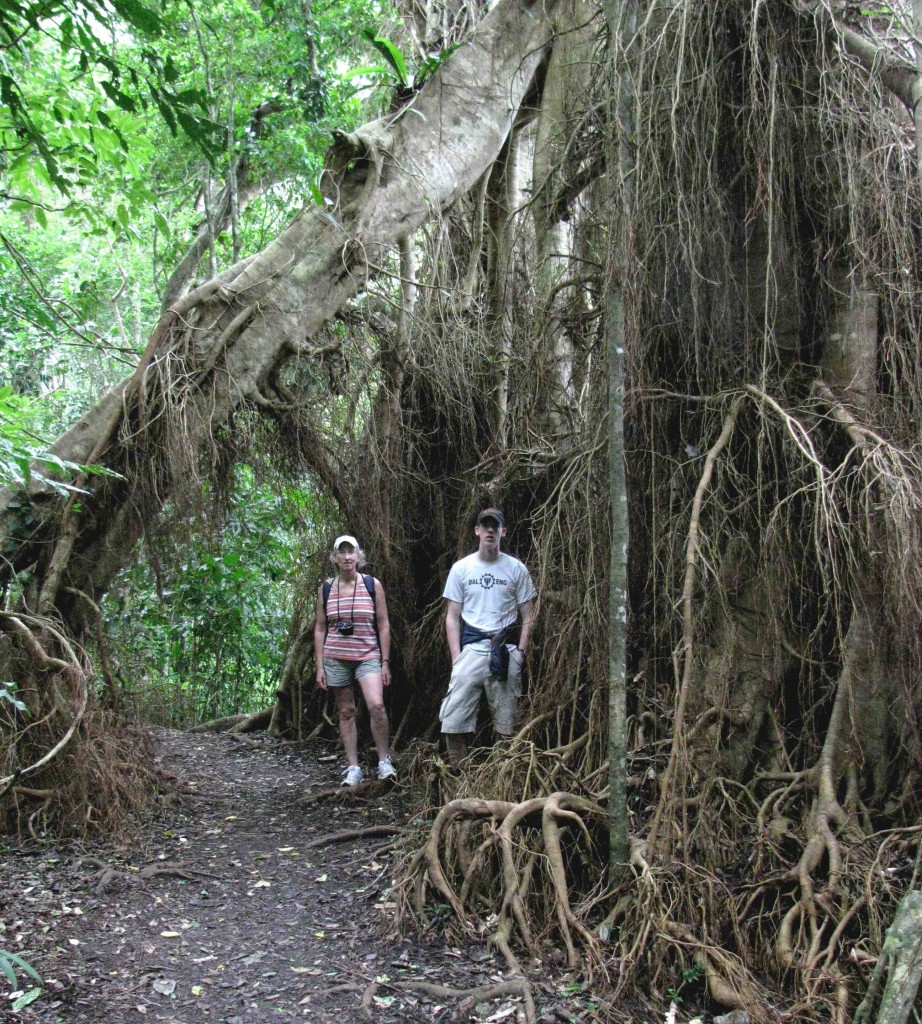
Janis and I under Fig Tree, Lake Eachem Track (© Vilis Nams)
We hiked the circuit track around Lake Eacham, pausing to watch saw-shelled turtles swim among fish having three large, dark spots on their sides. An interpretive sign informed us that saw-shelled turtles are ‘bum-breathers.’ They pump water in and out of their cloacas, wherein thousands of tiny fingers of tissue rich in blood vessels absorb oxygen from the water. By breathing through their bottoms, the turtles can stay underwater for long periods of time. (They also swim to the surface to breathe air into their lungs.)
The track led us through dense, dimly-lit rainforest tangled with vines and cluttered with an uncompromising array of plants bearing very effective defensive structures. Wait-a-while palms dangled barbed tendrils down over the path and repelled would-be grabbers with fiercely-spiked stems. Stinging trees with heart-shaped leaves bore thousands of silvery, needle-like hairs filled with toxin. Arching, strap-like leaves of plants growing in dense clumps were edged and ribbed with curved teeth. That tropical rainforest, so thick and rich with plant life, was definitely on guard and ready to fight back.
Janis climbed a thornless vine, and then swung from it across a patch of forest floor. Other vines created impenetrable tangles. Along the lakeshore, massive fig trees rose like fortresses and leaned out over the water, trailing their curtains of descending roots and enticing us onto and among their trunks. Although the figs were impressive in size, the remainder of the rainforest trees (regenerating after logging) were relatively slim and densely distributed. The thick vegetation made birding difficult, although I did spot a white-throated tree creeper scaling a tree trunk in quick bursts of motion, and a heavy-bodied wompoo fruit-dove perched among a clutter of branches. The dove’s plumage was a glorious collage of brilliant green, pale grey, yellow, and rust.
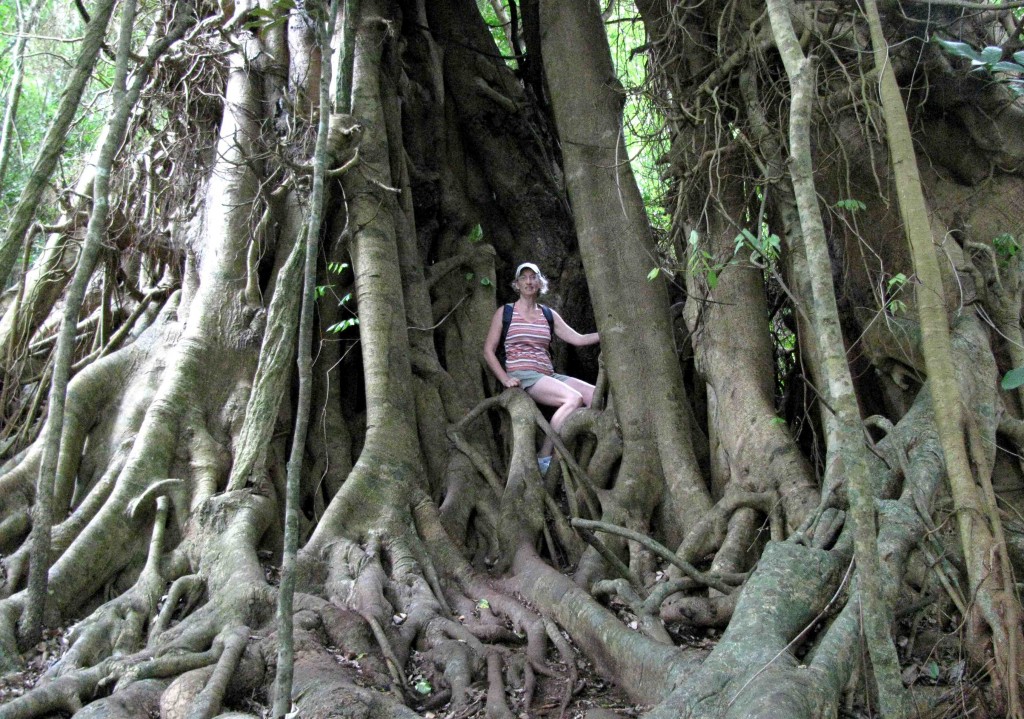
Here I am tucked among the roots of a Fig Tree, Lake Eachem Track (© Vilis Nams)
After a brief swim in the lake, we proceeded north to Lake Barrine, where Pacific black ducks and a small cruise boat floated on the water. A tearoom nestled on the lakeshore and was bordered by a small, manicured garden. Again, we chose a circuit track encircling the crater lake, which soon led us past a pair of bull kauris. An interpretive sign informed us that the 45-metre-tall trees, with their flaky, orange-pink bark and 6-metre girths, were examples of Australia’s largest coniferous tree species. They’re considered rare, and most are restricted to a section of the Atherton Tablelands between Malanda and Atherton.3
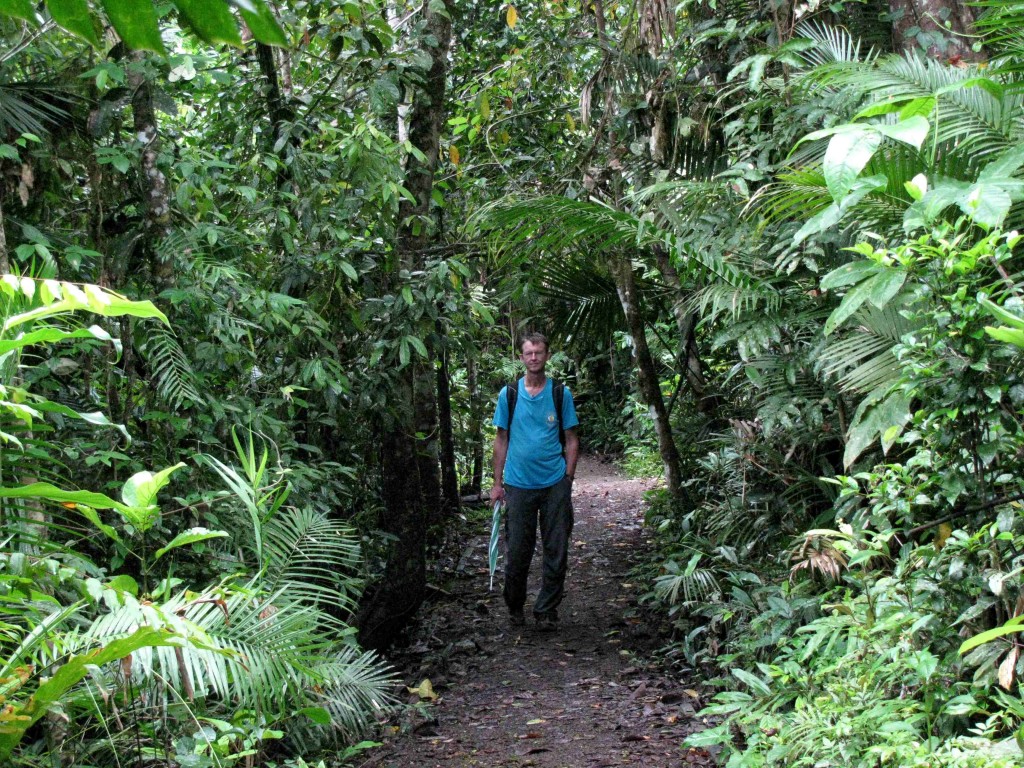
Vilis on Lake Barrine Circuit Track (© Magi Nams)
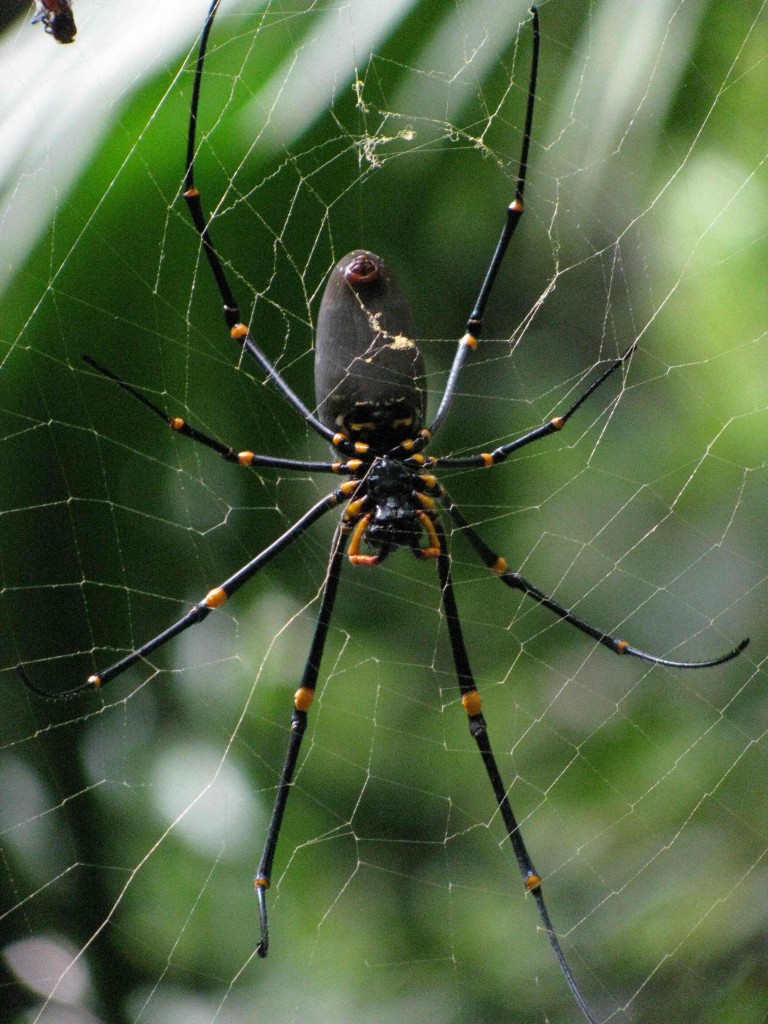
Female Golden Orb Web Spider (© Vilis Nams)
The rainforest surrounding Lake Barrine was noticeably more open than that at Lake Eacham and featured a dense understory of palms and shrubs. Again, huge figs leaned out over the lake edge, and we spotted a strangler fig that had killed its host tree, the fig’s interlaced trunks forming a thick net tube ascending to the sky. I noted a golden whistler and pale-yellow robin singing and flitting in lakeside trees, and a spotted catbird skulking silently in a dense cluster of branches. A spider spanning 15 centimetres and having brilliant yellow joints rested in the centre of a web almost a metre square in area. “I wonder if it’s poisonous,” Vilis mused while photographing it. (I later identified the spider as a female golden orb web spider, which is harmless to humans.)
From within the shelter of the rainforest, we watched curtains of rain fall onto the lake, feeling few, if any, raindrops. Still, we paid for our rainforest hike in other ways. Vilis inadvertently touched a stinging tree needle and felt the pain of that single dose of toxin for hours. Janis tore a finger on the barbs of a wait-a-while palm, and I unknowingly picked up a land leech that chewed a small, bloody hole in the back of my leg while consuming its meal. The rainforest, we had learned, is not to be taken lightly.
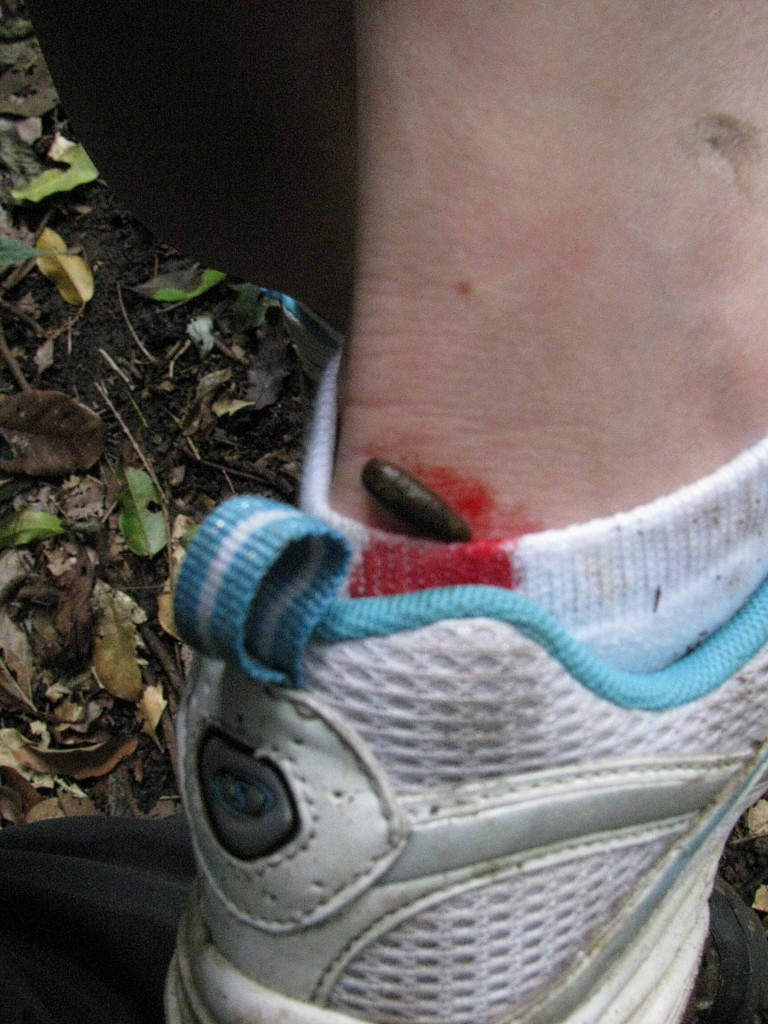
Land Leech (© Vilis Nams)
With several hours of daylight remaining before dusk, we drove west through rain and mist from the national park to Atherton, passing fields of corn and sugarcane. After two consecutive rainforest walks, Janis and I needed a change, which was exactly what the rocky, sparsely-vegetated Mount Baldy track offered.
After a brief rest stop in Atherton – another ‘real country town’– we raced against the dim light, pushing hard to scale Mount Baldy. A fresh wind swept sheets of mist across the low peak, cooling us as we climbed the steep, exposed slope covered with grasses and stunted, scattered trees. At one point, Vilis called urgently, “Janis, stop! There’s a snake.” By that time, Janis, who was looking ahead rather than down at the track, had stepped over the long, plain grey-brown snake. He stopped, and we watched the snake slither slowly from the track into grasses beside it. When Vilis stepped closer to photograph it, the snake reared up, opening its mouth.
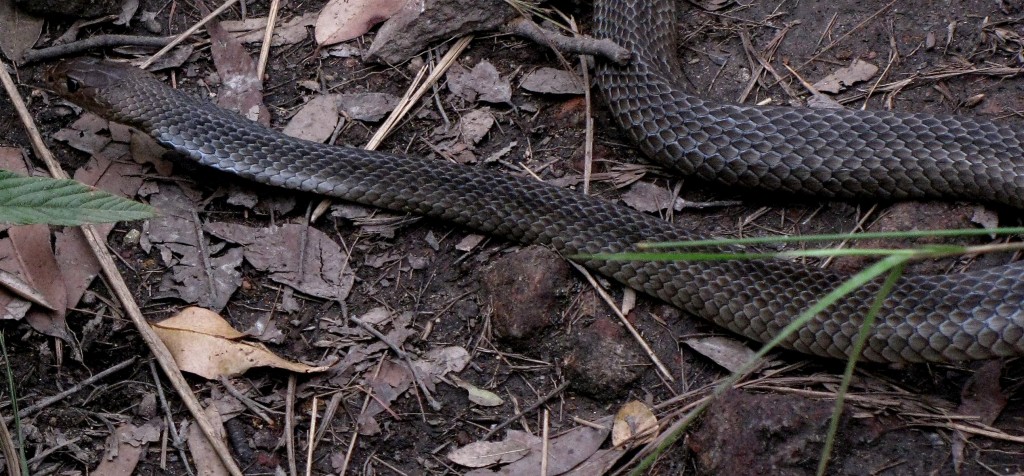
Eastern Brown Snake (©Vilis Nams)
“Step back from it,” I told Vilis. “That’s an aggressive defensive posture.” My mind began clicking through the few snakes I could positively identify without my guide and other identification aids, but the serpent was none of them. That left several other possibilities, most of which were highly venomous. Later, I studied my reptile guide and, through a process of elimination based on geographical range and physical characteristics, decided that the snake was most probably an eastern brown snake. Janis, on his fourth day in Australia, had unknowingly stepped over the second most poisonous snake in the world.
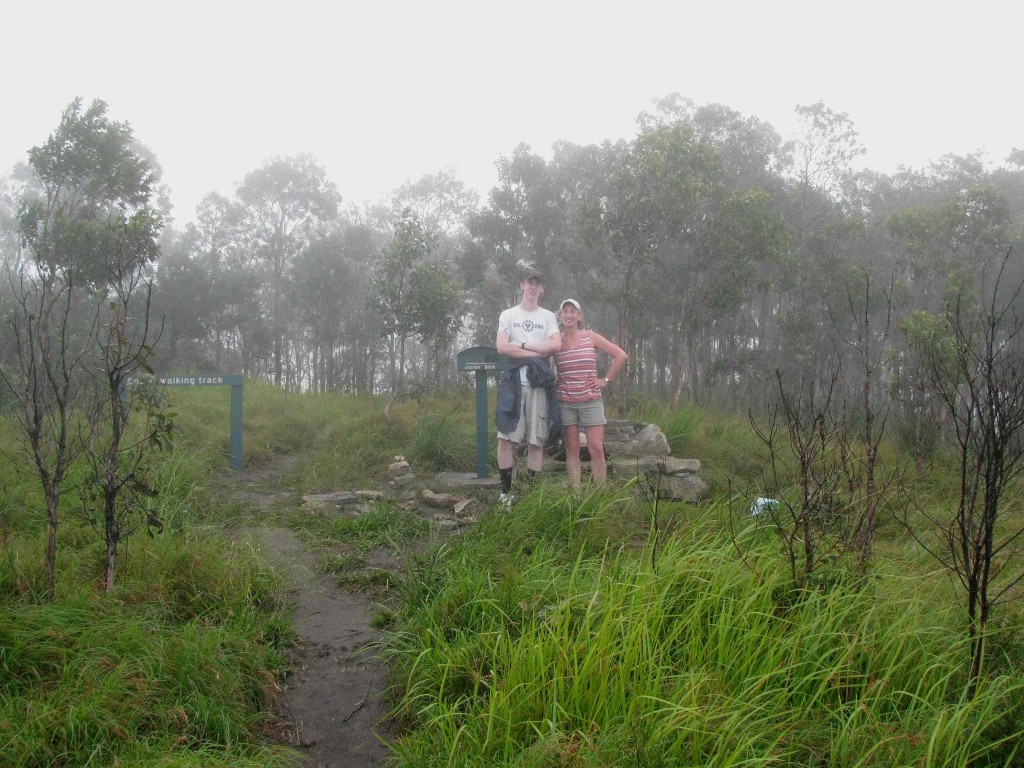
Janis and I on the Summit of Mount Baldy (© Vilis Nams)
Giving the snake a wide margin, we resumed our climb through cool, mist-shrouded air that blurred the vegetation around us and completely obliterated any long view of the Atherton Tablelands. At the summit, we paused for a breather before descending the rugged track. Janis spotted the snake again on the way down, and as before, it slithered off the track, this time into thick grass where it was essentially invisible. “How many other snakes have we passed that we didn’t even know were there?” Vilis wondered aloud.
The mist of our climb became steady rain as we drove the 20 kilometres from Atherton to Malanda, arriving at the Malanda Falls Caravan Park as darkness fell. We set up camp beside an old camp kitchen having lights and a roof extending out over a long table, all of which were a blessing during the dark, wet evening. After supper, Vilis and I probed the sheets of rain with flashlight beams, looking for nocturnal wildlife – in particular, those endangered tree kangaroos – but saw nothing. The rainforest, with its blatantly hostile understory plants, was remarkably secretive with its mammals. Only after I had crawled into my sleeping bag did I hear loud, screeching snarls which Vilis excitedly informed me had been emitted by two brushtail possums battling in a tree beside the camp kitchen. There had been fur flying, and blood – one more reminder that the rainforest isn’t all beauty.
References:
1. Emma Gregg. The Rough Guide to East Coast Australia. 2008. Rough Guides, New York. p. 2.
2. Kym Dungey and Jane Whyltaw. Tropical Walking Tracks of North Queensland. 2007. Footloose Publications. p.98.
3. M.W. McDonald, coordinator. Forest Trees of Australia, 5th edition. 2006. CSIRO Publishing, Collingwood, Victoria. p. 36.

